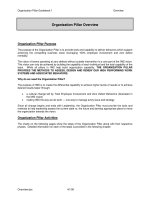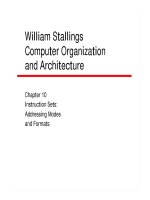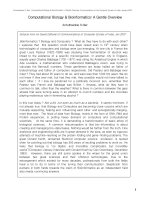UMTS Architecture Overview ppt
Bạn đang xem bản rút gọn của tài liệu. Xem và tải ngay bản đầy đủ của tài liệu tại đây (1.91 MB, 359 trang )
UMTS Architecture Overview
UMTS Architecture Overview
by Dr Paul Raby
by Dr Paul Raby
Public Land Mobile Network (PLMN)
▪
A PLMN can be regarded as an
independent
telecommunications entity.
▪
A PLMN is defined as:
▫
One or more switches with:
▪
a common numbering plan
▪
a common routing plan
▫
Switches act as the interface to
external networks
▪
The PLMN can be separated
into
▫
Core Network
▫
Access Network
Core Network
Access Network
PLMN
System Architecture Overview
User Equipment
UMTS
Terrestrial
Radio Access
Network
Core Network
U
U
I
U
UE
UTRAN
CN
UMTS High Level Architecture
System Architecture Overview
Major Network Elements in UMTS
PLMN,
PSTN,
ISDN
Internet,
X25
Packet
Network
U
U
UE
C
U
USIM
ME
Mobile
Equipment
UMTS SIM
CN
MSC/VLR
SGSN
GGSN
GMSC
HLR
Serving GSN
Gateway
GSN
Gateway
MSC
Mobile Switching
Centre
Home Location
Register
I
U
UTRAN
I
Ub
I
Ur
Node B
Node B
Node B
Node B
RNC
RNC
Radio Network
Controller
Radio Network
Controller
I
u-ps
I
u-cs
I
Ub
System Architecture Overview
General UTRAN Architecture
U
U
I
U
UE
UTRAN
I
Ub
I
Ur
Node B
Node B
Node B
Node B
RNC
RNC
Radio Network
Controller
Radio Network
Controller
I
u-ps
I
u-cs
I
Ub
CN (MSC)
CN (SGSN)
System Architecture Overview
Elements of UTRAN
▪
Radio Network Controller
▫
Owns and controls radio resources in its domain (BSC in GSM)
▫
Service Access Point for all services that UTRAN provides for the CN
▫
Note: Service RNC (SRNC) and Drift RNC (DRNC) are subsets
▫
Note: Control RNC (CRNC ) whichever RNC is talking to the UE
▪
Node B
▫
Acts as the radio base station (BTS in GSM)
▫
Converts the data flow between the I
ub
and U
u
interfaces
System Architecture Overview
Major Interfaces in UMTS
▪
There are four major new
interfaces defined in UMTS
▫
I
u
▪
The interface between UTRAN
and the CN
▫
I
ur
▪
The Interface between different
RNCs
▫
I
ub
▪
The interface between the
Node B and the RNC
▫
U
u
▪
The air interface
RNC
Node-
B
RNC
UE
CN
U
u
I
u
I
ub
I
ur
System Architecture Overview
UMTS Interface Implementation
ATM/IP Network
RNC
Node
B
Node
B
Node
B
MSC
RNC
SGSN
Node
B
I
ub
I
u_cs
I
u_ps
I
ur
System Architecture Overview
Handover in UMTS
▪
There are 3 basic types of handover
▫
Intra frequency handovers
▪
Handovers between 2 UMTS carriers at the
same frequency
▪
These can be soft handovers
▫
Inter frequency handovers
▪
Handovers between 2 UMTS carriers at different
frequencies
▪
These are hard handovers
▫
Inter system handovers
▪
Handovers between UMTS and GSM carriers
▪
These are hard handovers
System Architecture Overview
Macrodiversity between Node B’s
▪
If Active Set consists of
▫
two connections to cells
parented to different Node Bs
▫
then the combining of the two
channels occurs at the RNC
▪
This is known as a soft
handover
▪
This doubles the
transmission ‘cost’ of the
call
RNC
Node
B
Cell
Cell
Cell
Node
B
Cell
Cell
Cell
I
ur
I
u
U
u
System Architecture Overview
Maximal Combining between Cells on the
Same Node B
RNC
Node
B
Cell
Cell
Cell
Node
B
Cell
Cell
Cell
I
ur
I
u
U
u
▪
If Active Set consists of
▫
two connections to cells
parented to the same Node
B
▫
then the combining of the
two channels occurs at the
Node B
▪
This is known as a softer
handover
▪
This has no transmission
implication (but does have
capacity implications) if
cells are collocated.
▪
Uses maximal combining
▫
Adds electrically the
signals making one better
than each individual
System Architecture Overview
Architecture of a UMTS bearer service
TE
TE
UE
UTRAN
CN
edge node
CN
gateway
End-to-End
TE/UE Local
Bearer
UMTS Bearer
External Bearer
Radio Access Bearer
CN Bearer
Radio Bearer I
u
Bearer
Backbone Network
UTRA FDD/TDD
Physical Bearer
Each bearer service on a specific layer provides services using layers below.
System Architecture Overview
UMTS Protocol Stratums
▪
Non-access Stratum
→
Encompasses layers 4 to
7 of the OSI 7 layer
model, and the upper part
of layer 3
N
o
n
A
c
c
e
s
s
S
t
r
a
t
u
m
A
c
c
e
s
s
S
t
r
a
t
u
m
L1
L1
L1
L1
L2
L2L2
L2
L5
L5
L4
L4
L6
L6
L7 L7
L3 lower
L3 lower L3 lower
L3 lower
L3 upper
L3 upper
U
u
I
u
UE
UTRAN
CN
System Architecture Overview
•
Access Stratum
→
Encompasses layers 1
and 2 of the OSI 7 layer
model and the lower part of
layer 3
UMTS QoS Classes
▪
Conversational
▫
Speech over CS bearer
▫
Voice over IP, PS bearer
▫
Delay critical, imposed by human perception
▪
Streaming
▫
Multimedia streaming
▫
Using buffers, for non-real time delivery; real-video, real-
audio
▪
Interactive
▫
Web browsing, database retrieval
▫
Round trip delay time is a key parameter
▪
Background
▫
▫
Delay:- 10s of seconds or even minutes
System Architecture Overview
Protocol Model for UTRAN Interfaces
▪
Protocol structures in UTRAN are designed in layers and planes.
▪
They are seen as logically independent of each other
▫
However they will physically interact.
▪
Being logically independent allows for changes to blocks in the
future
theoretically!
System Architecture Overview
General Protocol Model for
UTRAN Terrestrial Interfaces
System Architecture Overview
Horizontal Layers in the General Protocol Model
▪
All UTRAN related issues are only visible in the Radio
Network Layer
▪
The Transport Layer simply represents standard transport
technology for use in UTRAN
▫
e.g. ATM and appropriate ATM Adaptation Layers
▪
AAL2 ( voice ) and AAL5 ( data/control)
▫
UDP/IP or RTP/UDP/IP ( release 6 ? )
System Architecture Overview
Vertical Planes in the General Protocol Model
▪
The Control Plane is provided for all UMTS
specific control signalling including:
▫
Application Protocols
▫
Signalling Bearers
▪
The User Plane is provided for all data sent and
received by the user including:
▫
Data Streams
▫
Data Bearers
System Architecture Overview
Vertical Planes in the General Protocol Model
▪
The Transport Network Control Plane also includes the Access
Link Control Application Part, ALCAP.
Transport
Network User
Plane
Transport
Network User
Plane
Transport
Network Control
Plane
ALCAP
System Architecture Overview
UMTS Technology Overview
CDMA - Direct Sequence Spread Spectrum
UMTS Technology Overview
f
r
e
q
u
e
n
c
y
time
code
Frame Period (we may still need
frames/timeslots for signaling)
CDMA Spreading
•
Essentially Spreading involves changing the symbol rate on the air interface
Identica
l codes
Tx Bit Stream
P
f
Code Chip Stream
Spreading
P
f
Channel
Air Interface
Chip Stream
P
f
Code Chip Stream
Despreading
P
f
Rx Bit Stream
P
f
UMTS Technology Overview
Spreading and Despreading
Rx Bit Stream
Air Interface
Chip Stream
Tx Bit Stream
1
-1
Code Chip Stream
X
Spreading
Code Chip Stream
X
Despreading
UMTS Technology Overview
Spreading and Despreading with code Y
Air Interface
Chip Stream
Tx Bit Stream
1
-1
Code Chip Stream
X
Spreading
X
Despreading
UMTS Technology Overview
Code Chip Stream Y
Rx Bit Stream
Spreading
▪
If the Bit Rate is R
b
, the Chip Rate is R
c
, the energy per bit E
b
and the energy per chip E
c
then
▪
We say the Processing Gain G
p
is equal to:
▪
Commonly the processing gain is referred to as the
Spreading Factor
b
c
cb
R
R
EE
×=
b
c
p
R
R
G
=
UMTS Technology Overview









